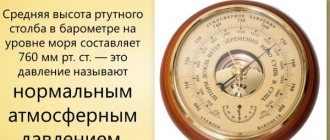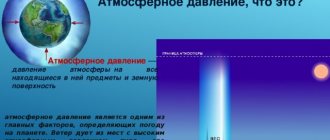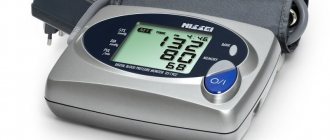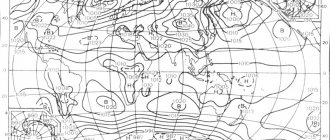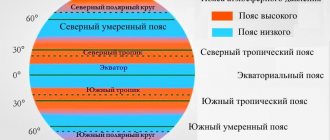In the Samara region, atmospheric pressure has increased due to an extensive anticyclone.
As reported to Samru.ru in the Privolzhsky UGMS, currently at eight stations in the region the maximum pressure values for October are blocked (or repeated) - 1-2 mm more than the 1987 record, and in Kinel-Cherkassy - 8 mm more than the 2000 record .
In Samara, the pressure is 775 mmHg, in Bezenchuk - 784, and in Tolyatti - 782. At the same time, the norm for October in the region is on average from 741 to 759 mmHg.
In the next 24 hours, due to the influence of the central part of the anticyclone, high pressure will remain. At the same time, the head of the HMC Lyudmila Anurova explained that such pressure is not very useful for humans, but it is still stable, so the harm to health is not as great as with fluctuations.
Many people are susceptible to changes in the environment. A third of the population is affected by the attraction of air masses to the earth. Atmospheric pressure: the norm for humans, and how deviations from the indicators affect the general well-being of people.
Changes in the weather can affect a person's condition
What atmospheric pressure is considered normal for humans?
Atmospheric pressure is the weight of air that presses on the human body. On average, this is 1.033 kg per 1 cubic cm. That is, 10-15 tons of gas control our mass every minute.
The standard atmospheric pressure is 760 mmHg or 1013.25 mbar. Conditions in which the human body feels comfortable or adapted. In fact, an ideal weather indicator for any inhabitant of the Earth. In reality, everything is not like that.
Atmospheric pressure is not stable. Its changes are daily and depend on the weather, terrain, sea level, climate and even time of day. The vibrations are not noticeable to humans. For example, at night the mercury rises 1-2 notches higher. Minor changes do not affect the well-being of a healthy person. Changes of 5-10 or more units are painful, and sudden significant jumps are fatal. For comparison: loss of consciousness from altitude sickness occurs when pressure drops by 30 units. That is, at a level of 1000 m above the sea.
The continent and even an individual country can be divided into conventional areas with different average pressure levels. Therefore, the optimal atmospheric pressure for each person is determined by the region of permanent residence.
An example of the distribution of atmospheric pressure over Russia in January
The flexible human body has the potential to adapt to unfamiliar natural conditions. The notorious resort acclimatization is an example of this. It happens when restructuring is impossible. So the inhabitants of the mountains suffer from poor health in the lowlands, no matter how long they stay there.
The warmest, coldest, sunny and snowy month in Samara
As weather statistics
,
the warmest month in Samara is July
with an average temperature of +21.1°C.
The second place is August (+20.2°С), the third is June (+19.4°С). Accordingly, the coldest month in Samara
is January.
The average monthly temperature in January is only −9.7°C. Samara has the most sun
in August.
Thus, August is the sunniest month in Samara
.
Let us know if this table is useful to you? Useful table (2341) No (510)
| The warmest | |
| July | +21.1°С |
| August | +20.2°С |
| June | +19.4°С |
| The coldest | |
| January | −9.7°С |
| February | −9°С |
| December | −7.1°С |
| More sun | |
| August | 16 days |
| May | 15 days |
| June | 15 days |
| More snow | |
| January | 1 day |
| December | 1 day |
| February | 1 day |
What effect does atmospheric pressure have on humans?
Atmospheric and blood pressure are interrelated. A decrease in mbar (cloudy, rainy weather) affects the body:
- lowering blood pressure;
- drowsiness and apathy;
- decreased heart rate;
- difficulty breathing;
- rapid fatigue;
- dizziness and pain;
- nausea;
- problems with the gastrointestinal tract;
- migraine.
Feeling drowsy during rainy weather
People with depressed respiratory functions are also at risk for hypotension. Their health on such days is characterized by aggravated symptoms and attacks. Cases of hypotensive crisis are becoming more frequent.
Increased air pressure (clear, dry, windless and warm weather) brings depressed health to hypertensive patients. The symptoms are opposite:
- increased blood pressure;
- increased heart rate;
- facial redness;
- headache;
- noise in ears;
- dizziness;
- pulsation in temples;
- “flies” before the eyes;
- nausea.
High air pressure has a negative effect on hypertensive patients
Such weather conditions are generous for strokes and heart attacks.
Hypertonic disease
Arterial hypertension
,
hypertension ; hypertension
- syndrome of increased systolic blood pressure (SBP) ≥ 140 mm Hg. Art. and/or diastolic blood pressure (DBP) ≥ 90 mm Hg. Art.
Essential hypertension (hypertension) is a disease of unknown etiology, the main manifestation of which is an increase in blood pressure, i.e. arterial hypertension.
Hypertension accounts for 90–95% of cases of hypertension. In other cases, secondary, symptomatic arterial hypertension is diagnosed: renal (nephrogenic) - 3-4%, endocrine - 0.1-0.3%, hemodynamic, neurological, stress, caused by the intake of certain substances (iatrogenic) and hypertension in pregnant women, in which increased blood pressure is one of the symptoms of the underlying disease.
Here we will talk specifically about hypertension.
According to statistics, 30-45% of the adult population suffers from hypertension. Before the age of 50, the disease is more often observed in men, after 50 years – in women. The prevalence of hypertension increases with age and reaches 50–65% in people over 65 years of age.
The causes of hypertension are currently far from completely clear. WHO experts identify a number of risk factors for arterial hypertension: age, gender, sedentary lifestyle, consumption of excess salt in food, alcohol abuse, smoking, diabetes, obesity, high cholesterol, heredity.
The following blood pressure levels are accepted by the World Health Organization:
| Blood pressure categories | Systolic (upper) | Diastolic (lower) | |
| Optimal | < 120 | And | < 80 |
| Normal | 120 – 129 | and/or | 80 – 84 |
| High is normal | 130 – 139 | and/or | 85 – 89 |
| 1st degree hypertension | 140 – 159 | and/or | 90 – 99 |
| 2nd degree hypertension | 160 – 179 | and/or | 100 – 109 |
| 3rd degree hypertension | ≥ 180 | and/or | ≥ 110 |
| Isolated systolic hypertension (ISAH) | ≥ 140 | And | < 90 |
Blood pressure measurements should be taken after a five-minute rest and only on the shoulder
- 30 minutes before this, eating, drinking coffee, alcohol, physical activity, and smoking are not recommended.
- When measuring, your legs should not be crossed, your feet should be on the floor, your back should rest on the back of the chair.
- The hand is placed on the table at heart level
Failure to comply with these conditions may result in incorrect blood pressure measurements.
Blood pressure is measured at least twice on the same arm. If a difference in blood pressure level is detected in one arm of 5 or more mm Hg. carry out an additional, third, measurement. As a result, the average value is recorded. During the first measurement, the pressure is measured on both hands, and subsequently on the hand where it was higher. The difference in blood pressure between the left and right arms should not exceed 10 mmHg. Art. Larger differences should raise red flags for upper extremity vascular disease.
So why is hypertension dangerous? And hypertension is dangerous primarily due to its terrible complications - stroke, heart attack, acute and chronic heart failure, renal failure, progression of atherosclerosis. Since hypertension is very often asymptomatic, timely diagnosis and treatment are of key importance in preventing possible complications.
In order to diagnose hypertension, determine the degree of risk, optimize an individual treatment regimen (in addition to anamnesis, auscultation, blood pressure measurement), special instrumental studies are also necessary:
— ECG (electrocardiogram) allows you to identify hypertrophy of the heart, rhythm and conduction disturbances, signs of myocardial ischemia
— Daily monitoring of ECG and Holter blood pressure is necessary to determine the daily profile of hypertension, detect disturbances in heart rhythm and conduction, myocardial ischemia, hypotension, which is often not visible on a standard ECG.
— Blood test: complete blood count, glucose, lipid spectrum, urea, creatinine, ALAT, ASAT.
Using examination data (primarily ECG, daily monitoring of ECG and blood pressure), it becomes possible to select an effective antihypertensive therapy regimen, taking into account the individual characteristics of the patient and even in cases of so-called refractory hypertension.
The goal of treating hypertension is to reduce the risk of target organ damage (heart, brain, kidneys), because These organs suffer from high blood pressure first, even if there are no subjective sensations. In simple terms, the goal of treating hypertension is to reduce the likelihood of stroke, heart attack, improve quality of life and, ultimately, increase life expectancy itself.
In young and middle-aged people, as well as in patients with diabetes, it is necessary to maintain pressure at a level of up to 140/90 mm Hg. For elderly people, the target blood pressure level is up to 150/90 mm Hg.
The general principles of treatment of arterial hypertension are as follows:
– a diet for the purpose of normalizing weight in case of excess, correcting blood sugar and cholesterol
- moderate physical activity 3-5 times a week (walking, running, swimming, physical therapy),
- to give up smoking,
- reducing alcohol consumption,
If there is no effect from the above methods in the treatment of 1st degree arterial hypertension, as well as patients with 2nd and 3rd degrees of hypertension, proceed to taking medications.
It should be noted that pharmacies currently offer a wide range of different medications for the treatment of arterial hypertension, both new and known for many years. Drugs containing the same active ingredient may be produced under different trade names. It is quite difficult for a non-specialist to understand them, but despite the abundance of drugs, their main groups can be distinguished, depending on the mechanism of action:
Diuretics are the drugs of choice for the treatment of hypertension, especially in the elderly.
ACE inhibitors have been used for many years and are well studied and effective.
Sartans (or angiotensin II receptor blockers) are similar in their mechanism of action to ACE inhibitors:
Beta blockers . Currently, highly selective drugs with minimal side effects are used.
Calcium antagonists according to their mechanism of action are divided into 2 main groups, which is of great practical importance:
- dihydropyridine (amlodipine, felodipine, nifedipine, nitrendipine, etc.)
- non-dihydropyridine (verapamil, diltiazem).
Drugs with a central mechanism of action
Also, when treating arterial hypertension, it is important to correct risk factors
- antiplatelet agents - acetylsalicylic acid (for example, Cardiomagnyl, Thrombo-ACC) are used according to indications,
- statins in the presence of atherosclerosis
- drugs that lower blood glucose levels in the presence of diabetes mellitus.
In any case, for treatment and examination of hypertension, you must contact a cardiologist. Self-medication is unacceptable! Only a specialist (cardiologist), after a full examination and analysis of the examination results, will be able to correctly diagnose and prescribe competent treatment.
The prognosis significantly depends on the adequacy of the prescribed therapy and the patient’s compliance with medical recommendations.
Meteor dependence - what to do?
The movement of mercury by more than one division in 3 hours is a reason for stress in the strong body of a healthy person. Each of us feels such fluctuations in the form of headaches, drowsiness, and fatigue. More than a third of people suffer from weather dependence to varying degrees of severity. In the zone of high sensitivity are populations with diseases of the cardiovascular, nervous and respiratory systems, and elderly people. How to help yourself if a dangerous cyclone is approaching?
15 ways to survive a weather cyclone
There's not a lot of new advice here. It is believed that together they alleviate suffering and teach the correct way of life in case of weather vulnerability:
- See your doctor regularly. Consult, discuss, ask for advice in case your health worsens. Always have prescribed medications on hand.
- Buy a barometer. It is more productive to track the weather by the movement of the mercury column, rather than by knee pain. This way you will be able to anticipate the approaching cyclone.
- Keep an eye on the weather forecast. Forewarned is forearmed.
- On the eve of a weather change, get enough sleep and go to bed earlier than usual.
- Adjust your sleep schedule. Provide yourself with a full 8 hours of sleep, getting up and falling asleep at the same time. This has a powerful restorative effect.
- Meal schedule is equally important. Maintain a balanced diet. Potassium, magnesium and calcium are essential minerals. Ban on overeating.
- Take vitamins in a course in spring and autumn.
- Fresh air, walks outside - light and regular exercise strengthens the heart.
- Don't overexert yourself. Putting off household chores is not as dangerous as weakening the body before a cyclone.
- Accumulate favorable emotions. A depressed emotional background fuels the disease, so smile more often.
- Clothes made from synthetic threads and fur are harmful due to static current.
- Keep folk remedies for relieving symptoms in a list in a visible place. It’s hard to remember a recipe for herbal tea or a compress when your temples are aching.
- Office workers in high-rise buildings suffer more often from weather changes. Take time off if possible, or better yet, change jobs.
- A long cyclone means discomfort for several days. Is it possible to go to a quiet region? Forward.
- Prevention at least a day before the cyclone prepares and strengthens the body. Do not give up!
How to feel better
It is very important to know how to eliminate the negative effects of the cyclone and anticyclone and improve your condition. This is especially true for weather-sensitive people, the elderly, patients with diagnosed pathologies of the respiratory, cardiovascular and central nervous systems.
In order to avoid adverse consequences and improve your well-being, you must take into account the following recommendations from specialists:
- Eat a balanced diet, avoiding the abuse of sweets, fatty, fried, spicy foods;
- Purchase a barometer that will allow you to monitor changes in atmospheric pressure and promptly take measures aimed at stabilizing your physical condition;
- Get proper rest and sleep;
- Follow a routine, trying to wake up and fall asleep at approximately the same time;
- Regularly study the weather forecast;
- Take walks in the fresh air;
- Give your body regular, feasible physical activity.
If you feel unwell due to changes in atmospheric pressure, it is recommended to consume less salt, do therapeutic exercises, drink green tea and herbal decoctions.
Consultation with a specialist will allow you to choose the best methods for improving your physical condition and eliminating unpleasant symptoms caused by the influence of atmospheric pressure!
What is weather dependence?
Weather dependence is the inability of the human body to adapt to changing weather conditions.
People suffering from vegetative-vascular dystonia, hypertension, atherosclerosis, and endocrine diseases are more prone to weather dependence. The baroreceptors of our organs react to the approach of a cyclone or anticyclone, reducing or increasing blood pressure, making them dependent on weather conditions.
The effect of high atmospheric pressure on blood pressure
An increase in atmospheric pressure forces blood pressure to equalize the imbalance. Blood pressure decreases, the walls of blood vessels expand. Consequences of hypotension:
- concerned about poor health and general weakness;
- suffer from headaches;
- there is an unpleasant “fullness” in the ears;
- Chronic diseases are getting worse.
Blood chemistry under these conditions will show a decrease in white blood cell levels, which means the immune system will have a harder time fighting off the infection or virus. The best solution in this situation:
- do not overexert yourself and have a good rest;
- limit alcohol intake during this time;
- enrich the diet with foods containing potassium (dried fruits) and magnesium (cereals, rye bread).
Return to contents
The effect of low atmospheric pressure on humans
A drop in atmospheric pressure when the weather changes leads to symptoms that are similar to mountain climbing. An insufficient amount of oxygen is unable to saturate the organs of the human body. Shortness of breath appears, the heart beats faster, pain presses in the temples and squeezes the head like a hoop. People with increased intracranial pressure, head injuries, and cardiovascular diseases react sharply to this.
Weather in Samara by months (table)
Below is the table of weather in Samara by month. In the table you will find such climate parameters in Samara as the average temperature in Samara by month
, average humidity in Samara by month, average wind speed in Samara by month,
number of sunny days in Samara
by month,
number of rainy days in Samara
by month and other information.
Let us know if this table is useful to you? Useful table (4112) No (694)
| Month | average temperature | Average humidity | Wind speed | Amount of days | ||||
| Clear | Cloudy | Mainly cloudy | Rain | Snow | ||||
| January | −9.7°С | 84 % | 3.4 m/s | 4 | 21 | 4 | 1 | 1 |
| February | −9°С | 82 % | 3.4 m/s | 6 | 18 | 4 | 1 | 1 |
| March | −2.5°С | 77 % | 3.2 m/s | 9 | 16 | 3 | 1 | 0 |
| April | +6.9°С | 64 % | 3.6 m/s | 12 | 15 | 3 | 1 | 0 |
| May | +16.4°С | 54 % | 3.4 m/s | 15 | 13 | 1 | 0 | 0 |
| June | +19.4°С | 60 % | 2.8 m/s | 15 | 14 | 1 | 0 | 0 |
| July | +21.1°С | 60 % | 2.8 m/s | 15 | 14 | 1 | 0 | 0 |
| August | +20.2°С | 59 % | 2.7 m/s | 16 | 13 | 1 | 0 | 0 |
| September | +13.2°С | 66 % | 2.7 m/s | 14 | 13 | 3 | 0 | 0 |
| October | +6°С | 74 % | 3.1 m/s | 9 | 16 | 4 | 1 | 0 |
| November | −1.9°С | 84 % | 3.0 m/s | 6 | 18 | 3 | 2 | 0 |
| December | −7.1°С | 87 % | 3.0 m/s | 5 | 20 | 4 | 1 | 1 |
Temperature in Samara by month (graph)
The temperature in Samara varies depending on the month in the range from -9.7°C to 21.1°C. At the same time, the minimum temperature in Samara is observed in January, the maximum temperature in Samara is usually in July.
The average temperature graph in Samara by month is presented below:
Let us know if this chart is useful to you? Helpful Chart (1998) No (302)
Humidity in Samara by months (graph)
Humidity in Samara varies depending on the month in the range from 54% to 87%. At the same time, the minimum humidity in Samara is observed in May, the maximum humidity in Samara occurs in December.
The graph of average humidity in Samara by month is presented below:
Let us know if this chart is useful to you? Useful chart (1592) No (261)

